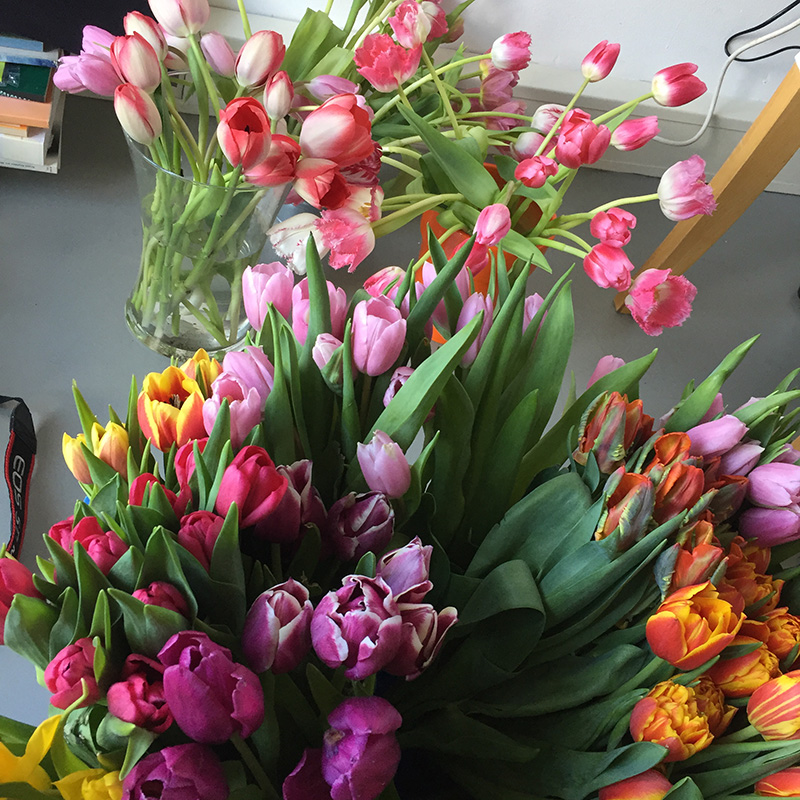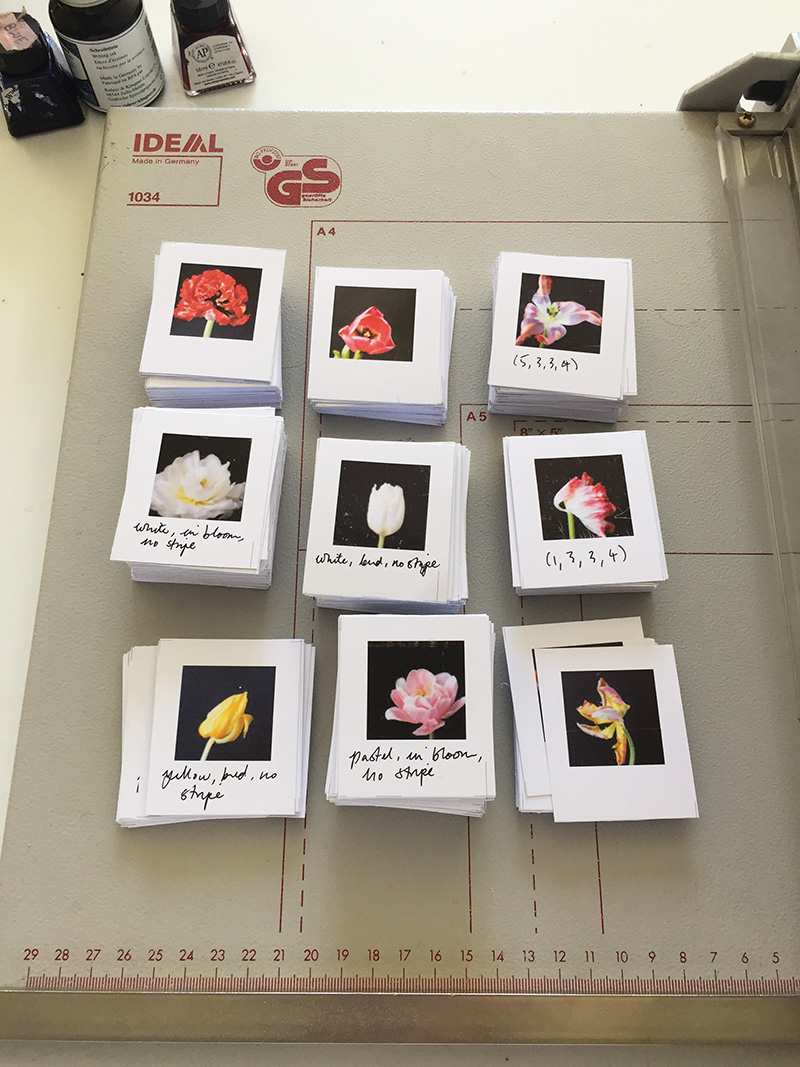
Anna Ridler is an artist and researcher who lives and works in London. She has degrees from the Royal College of Art, Oxford University, University of Arts London and have shown at a variety of cultural institutions and galleries including Ars Electronica, Sheffield Documentary Festival, Leverhulme Centre for Future Intelligence, Tate Modern and the V&A. She is a recipient of this year’s European Media Art Program (partnering with Impakt) and the winner of the 2018-2019 Dare Art Prize.
I got the opportunity to talk with Anna about the work she did as part of this year’s European Media Art Program and ideas and experiences that motivate her practice.
You just finished your Impakt Artist Residency. What did you do during your residency and what inspired it?
I remember a conversation I had with my mum nearly a decade ago about ‘tulip-mania’. This was bizarre moment in Dutch history in the seventeenth century when tulips – for no reason – went from being just a `thing’ to certain tulip bulbs costing the same amount as an Amsterdam Townhouse. Then the market crashed and they went to being the price of an onion. It was the first known speculative bubble.
As it was the seventeenth century people didn’t really understand why there were different types of tulips – why some looked the way that they did. One of the rarest types of tulips were the ones that had stripes in them. People didn’t understand how those stripes occurred and tried all sorts of things to make them like chopping a red tulip and white tulip in half and combining them or painting the earth with stripes to make stripy tulips. It wasn’t until the 20th century that it was discovered that a virus called the mosaic virus which is caused by bugs laying eggs in the bulb produces these stripes.
One of the things I’m really interested in is looking at the news and trying to collapse it or subvert it a little bit or think about it in a different way. One of the things that has constantly been on the tech news a lot has been bitcoin. I was really interested in the parallels that were going on with bitcoin and speculation and the tulips in the seventeenth century.
One of the outcomes [of the residency] was `Mosaic Virus’ - a video piece with generated images of tulips that change shape according to the price of bitcoin.
I decided that I wanted to use machine learning to make this piece because there are a couple of nice things that link in to that idea of 17th century Dutch tulip-mania and speculation in the stock market and bitcoin.
If you look at art history, Dutch still-life paintings of bouquets include flowers from different times of the year that could never exist in a bouquet at the same time. The bouquets are imagined. Pieced together from fragments of the artist’s mind and what they know about how flowers work. This was reminiscent of how when you get a GAN to dream, it starts to imagine things based on what it knows in the world. There is a link between how these things were traditionally done and how they are done now.
The other thing I quite liked about using machine learning for the project was that GANs are notoriously unstable. When they train they get better and better until they collapse and stop working, which is similar to how the stock market works, and the price of tulips back in the seventeenth century worked – getting higher and higher and suddenly collapsing.
There were these two nice things that meant using machine learning worked with the project rather than just being something I was using for the sake of it.
What was the process of developing this idea into your work Mosaic Virus?
It was incredibly laborious, much more than I thought it would be! To make it I created my own training set where I took 10,000 photographs of tulips. I had to find the tulips, then strip them to make ready for the photographs. I was in the Netherlands for two months during tulip season while I was there the price of tulips went up 300% during that time. The reason why I finished my training set was because by the end of the two months was not because I wanted to stop, it was because it was no longer the right season and it is too hot to grow tulips. So even though I’m working with something very algorithmic and mechanical there was still this element of this project that was very much based in nature. The timeline that I had to work to was driven by the seasons. You can’t just magic up tulips when there are no more tulips left.

I took all of these photographs which took a really, really long time. Part of the process of doing this made me realise the amount of labour and time that goes into creating these training sets. I found this really interesting, especially as a female practitioner, because back in the 1950s the idea of a ‘computer’ was a woman essentially. Someone who would do basic secretarial and administrative work. Someone who computes. By creating my own training set and doing everything it links back to that idea.
I needed labels on all of my photographs to know how stripy they, what stage of blooming they are in and what kind of tulip they are. So the other thing I had to do (and in fact am still doing because it takes so much time) is label every photograph. Doing this also makes apparent all the decisions that are made in making a dataset. No matter what program you are using or algorithm you are running someone has decided that this item is X rather than Y. Even with something as simple as a flower you still have questions about ‘is this red or is it pink’, ‘is this white or is it a pale yellow’, ‘is this blooming or is it dying’. It is really important for people to understand this and start to think about and question some of these assumptions that sit behind dataset creation.
To bring the human element out I’ve ended up making this training set a separate art piece. To begin with it wasn’t going to be, but it has ended up becoming an artwork which is talking about classification and the processes behind machine learning.
I printed out all of these photographs and hand-wrote my categorisations on them. I think the hand writing is important because it really emphasises this human element. In the process of labelling I would sometimes disagree with myself and cross it out and when you see them all up on a wall it invites the viewer to agree or disagree or question whether something is really ‘white’ or ‘red’ or is one thing or another. Because it is such a simple thing, a flower, it is very easy to extend that out to a conversation about how these categorisations are being used elsewhere. You can take something small and use that to then explore bigger things and I like working with minor things rather than big P political things.
Are these two separate works in your mind or do you intend to show them together?
They are two separate works because they are two very different ideas and they talk about two very different things but when they are shown together they work together to create a thing.. you can see links between the two. So they will be shown together but are two separate things.

A common criticism levelled at Creative AI systems is there is often a disconnect between the dataset and system creator. How do you approach selecting or putting together datasets for your projects?
I always work with self-generated data sets which either require me to make them, so draw them, photograph them or curate them, which would require a high level of editorial control – such as going through and scanning old books to find certain photographs. With my Wikileaks projects I’ve ended up reading through entire data dumps from Wikileaks to find bits that are interesting to work with.
If it is an off-the-shelf dataset and relatively off the shelf algorithm, there is nothing then to stop someone else from creating that. For me as an artist it is really important to make sure that work is my work.
There is also this huge thing around dataset bias. As someone who is interested in hidden things and things that have been obscured by history, it makes me uncomfortable to work with someone else’s dataset. There is this huge amount of cultural and social bias that goes in when you are creating archives or databases. When I make my own dataset it’s not that I stop doing those things but the bias in choosing what’s in and what’s out is in my control.
How did machine learning start coming into your art practice?
I worked with archives before I came into machine learning. I’ve always been interested in collections of things: what’s in them and not in them. It’s really important to look at every piece of what is going in to the dataset so I read everything or I will select everything or I will make everything that goes into the dataset that is then used for something else.
When I’m making a new work, I don’t want to use machine learning or AI just because it is there. I think about what it can do and how it can add to what I’m making. In the same way that when I make other work, I don’t just use photography because it is easier than drawing. I’m using technologies to really think about what are the associations? How does it work? How can all of these different things go in and help amplify or help construct the message or the thing I’m interested in… help unpick some of the ideas.
I’ve always been interested in using data and technology, and as machine learning become more and more prevalent and barriers to using it dropped it become a natural way of exploring this existing interest. My background is in literature and linguistics as well so the other quite nice thing is if you look at how these [Machine Learning Systems] work in labelling things, deciding when a thing is a thing, it all just came together which is why I think I find it so enjoyable to work with. It just naturally all fell together.
[END INTERVIEW]
Anna is starting a year long commission from Opera North “to work with scientists in the Language and Memory Laboratory, and the wider School of Psychology, at the University of Leeds to explore the functions of memory and the roles of the left and right sides of the brain, and how their operation might be embodied in a work of art.”
Discuss this article on Twitter
About the Author
 |
Anna Ridler is an artist and researcher who works with information and data. She has exhibited at the V&A Museum, Ars Electronica and the Tate Modern and has degrees from the Royal College of Art, Oxford University and University of Arts London. Her interests include drawing, machine learning, data collection, storytelling, and technology. Follow Anna on twitter |
|---|---|